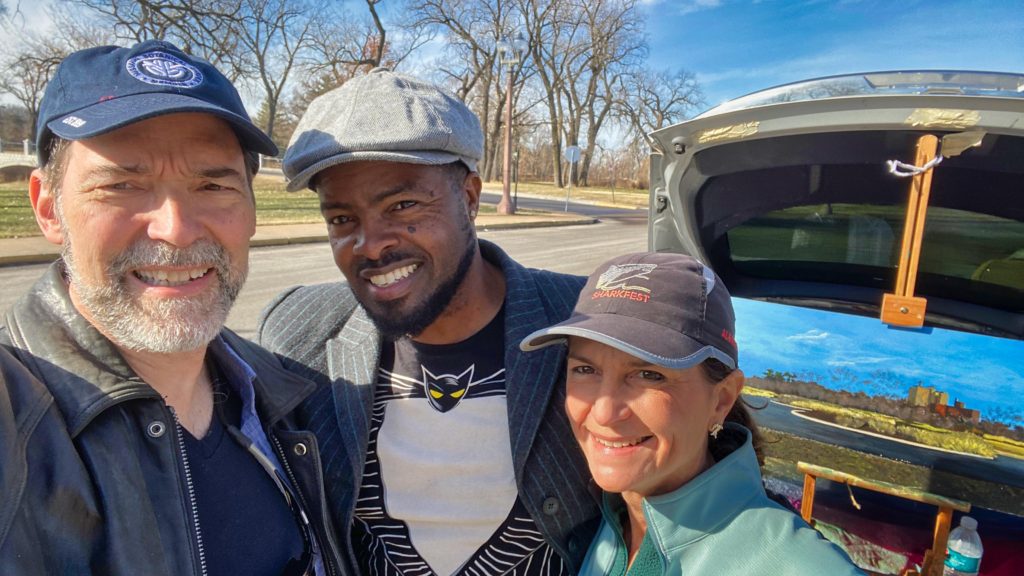Gravity-Defying Sculptures
I LOVE these gravity-defying sculptures. Maybe these were created by people who were half-sculptors and half-magicians . . .
I LOVE these gravity-defying sculptures. Maybe these were created by people who were half-sculptors and half-magicians . . .
Martha Ferdinand has been one of my favorite people ever since I began working with her at Arch City Defenders. More recently, we have made a habit of walking briskly through Forest Park while catching up with each other. And, of course, we often contemplate the human condition. We haven’t yet figured that out . . .
Today we took a little side-trip from our planned walk. I spotted a man painting a park scene across the street and suggested to Martha that perhaps it would be fun to go check out his work. Martha nodded, and that’s how we met “Frank James, Curbside Artist.” Frank explained that he has made a living of painting scenes of Tower Grove Park and, more recently, Forest Park. He pulled out other examples of his work from his car: several impressive detailed 30” wide panoramas of park scenes in acrylic paint. Frank offered far more than art today, however. He looked us over and offered an off-the-cuff character analysis of Martha with a big smile and lots of laughs, especially when she agreed that he was somewhat accurate. All of this while smooth music played quietly on his car stereo, but not an entire song. He only liked the first part of that song, so he cut off part where the “irritating” singer began to sing. He loops the pre-vocals beginning of the tune over and over. He explained that this is a significant part of his creative process.

We chatted for awhile about many things, not just painting, but also about his outlook on life, our thoughts on race relations and discussions about music we all enjoy (including Wes Montgomery and George Benson's Breezin’). Good vibes all around.
My friend John Simon often says, “It’s all about relationships.” I agree that this is an excellent default position for understanding almost any life situation. Certainly, my memory of Forest Park on this day will be dominated by the spirited conversations with both Martha and with that ebullient stranger-no-more, “Frank James, Curbside Artist.”
I have a theory too. It seems to me that unplanned spontaneous conversations are often the best, the most memorable. Those who know me well know that it’s hard to hold me back when I get the sense that a quirky
When they stop celebrating “How the Grinch Stole Christmas,” I’ll pause my efforts to reframe this story as having one of the worst endings in the history of story-telling.
Just when the Whos of the Who Village almost learned an extremely important lesson, just when they were having an epiphany that all of that Christmas kitsch and all those baubles actually corrupted the holiday and distracted from the meaning of the celebration, that’s when the Grinch got three times more evil that day.
A proper way to end the story would be for the Grinch to confidently dump all of that glittery tinselly crap into the abyss high above the village. He would then triumphantly ride down into the Who Village to be welcomed as a hero. They would sing odes praising the Grinch for conducting his dramatic intervention. They would deeply embrace the idea that Christmas would proceed in a more pristine and sincere form because the materialistic cravings--those jingtinglers, whohoopers and glumbloopas--had been exorcised from the process. The Whos might even celebrate that the Grinch was channeling the Jesus who drove the money-changers out of the temple. Instead of singing the “Twelve Days or Christmas,” the Whos would compose a new carol called “O Little Town Where Less is More.”
The actual story ending is a sad one, however. Because the Grinch allowed schmaltzy emotion to prevail over principle, he decided that Christmas should NOT become like traditional Thanksgiving (before the concept of Black Friday). He decided that the celebration needed thousands of materialistic distractions after all. The Whos, glitch-addicts that they were, put up no resistance. The story ending consisted of a lesson almost learned. No denouement here—that metaphorical sleigh just couldn’t quite get over the crest of the hill. This kind of almost-story could inspire a remake of “A Christmas Story” where Scrooge almost learned his lesson. In that revised ending, post-nightmare Scrooge would march back to the Cratchit house and spray paint anti-Cratchit graffiti on the walls.
Damn. The story of the Grinch was almost such a great story. See you next year for more of the same.
When I was a boy, I saw rock tumblers for sale in the Sears Catalogue, but I never had one and never knew anyone who had one. Well . . . decades later I do have a rock tumbler and I have recently learned that there are lots of beautiful rocks to be found only about an hour from St. Louis.

After a month of tumbling in my basement, this is what rocks from a Missouri creek look like (a creek near Farmington, Missouri). They shine even though they are perfectly dry. They are fun to hold and fun to look at. They were all so shy, modest about their beauty, while sitting in the creek. But now they are spreading their little peacock tails. Up close, some of them look like abstract works of art. To see many more images, click on the title to this post and then check out the gallery of photos.
Since I obtained my rock tumbler (a Thumler Model B), I've reached out and found dozens of other people who are passionate about finding and polishing rocks, as well as making jewelry and other objects of art out of them. These rock hounds are all over the place, and all you need to do to make them show up is to mention rocks.

For me, this has been a wonderful hobby, above and beyond the thrill of locating a beautiful rock in a creek or in seeing these polished specimens. I tend to think in the abstract throughout the day. I do it at the drop of a hat. These rocks, on the other hand, are real. I want to hold them and feel them and admire their beauty. This hobby has been an excellent counter-weight to my tendency to philosophize. It has, indeed, kept me "grounded."
I've dabbled with Photoshop over the years, but I have decided to (as Stephen Covey suggested) "sharpen the saw." In other words, I want to incorporate new tools so that I can get things done better and more efficiently when I use Photoshop. Shane Parrish of Farnham Street would identify this as "Compounding," which is a really cool concept, especially when applied to things other than earning interest on money.
And what a better time to learn tips on using photoshop than modern times, when you can attend Youtube University or pay a bit from many other online instructors? I've already incorporated one change when compositing, something I should have done years ago: Instead of trimming a the top image with the eraser tool, I've started making use of layer masks. That, and use of the "x" key to switch colors from black to white (black conceals, white reveals), has made it a joy to display only what I want on the top layer. Whenever you make a mistake, it's non-destructive and hitting the "x" key lets you bring back what you accidentally took away. What you'll see below is an image I created using the layer mask to display precisely what I wanted in my own body (I'm the guy on top). I'll paste in the FB commentary so you can experience the joke too:
Last night I spotted my buddy Eddie White at the Southside YMCA. Eddie is active duty U.S. Army and I think his military exercise routine requires him to bench press a house. I was happy to serve as his weight-lifting partner.
